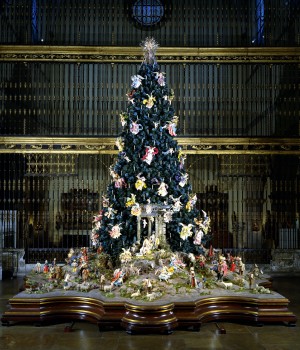Winter Wonderland in New York City’s Museums
The American Museum of Natural History
During the holiday season, storms of people visit the American Museum of Natural History in New York City for amongst the life like animals spanning from zebras to lions and the terrifying dinosaurs stands a Christmas tree donning beautifully crafted origamis. In fact, the entire tree located in the Grand Gallery is majestically decorated in over 500 to 800 different origami replications of animals and subjects found in the museum, which are inspired by an annual theme.
According to the AMNH, this year’s theme was roused by the World’s Largest Dinosaurs exhibition as the staff walked each hallway, examining the things that were of the largest size. Entitled The Biggest & The Best, the display features a blue whale (inspired by the model of the large blue whale hanging in the Milstein Family Hall of Fame), a Maori head, dinosaurs, stibnite, seashells, and even a replica of the African and Asian elephant. But what makes the display truly one-of-a-kind is that each decoration is painstakingly handcrafted by OrigamiUSA — as well as volunteers from across the world from such countries like Brazil, Columbia, Italy and Japan — with the use of cheap and basic to the most expensive and exclusive handmade colorful papers.
The tradition was started over 40 years ago with the founder of OrigamiUSA, Michael Shall, whose mission was to promote the craft of origami making. Though Shall passed away in 1995, his passion is continued by the other members of the organization. And with planning beginning as early as July, the OrigamiUSA team has more than enough time to concoct a plan of action before creating the elements for the museum’s annual display, which are put up within a week before Thanksgiving. Moreover, they aren’t the only ones who work on the decorations. Just like Shall, OrigamiUSA teaches origami classes on its premises as well as in various museums including AMNH, and according to the administrator of OrigamiUSA, Sam Riviello, some of these creations made by the students are then kept and used for the tree.
“The origami models are created by our members across the world. We offer numerous classes, so it is not impossible that the models you see on the tree were once taught at a class,” he said.
Furthermore, the AMNH provides origami classes during the holidays as an additional element to the display. However, none of these creations make it to the tree after it has been decorated. They are merely there to teach the basics of origami folding, and for the radiant joy of the children who come with their parents, mystified by the paper wonders hanging from the tree.
“We hold teaching tables at the museum to teach the public very basic models. The formal classes that are held during the tree’s duration do not provide models for our tree. We do not add to the tree once it is up and officially lit,” Riviello said.
“People are always surprised at the ability to create very specific, detailed models out of paper. We always hear from people about their favorite things they spotted on the tree,” he added.
According to Riviello, visitors aren’t the only ones who are captivated by the creations; he also has a personal favorite this year – the stibnite. Intricately folded to resemble the sulfide mineral, the origami is an accurate portrayal of the one present in the museum.
“This year, I am impressed with the stibnite. I love the paper used and how accurately it portrays the actual stibnite displayed in the museum,” he said.
And if the palette of multi-colored zebras and dinosaurs isn’t encouraging enough to visit the museum’s display, they also hold a Kwanzaa celebration on December 31 with festive performances ranging from singing, dancing, and even storytelling, capturing the diverse holiday spirits.
For museum visiting hours and visitor information, visit http://www.amnh.org.


